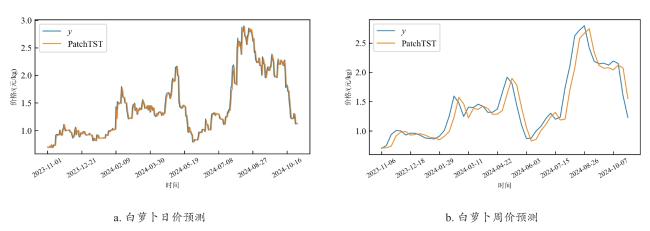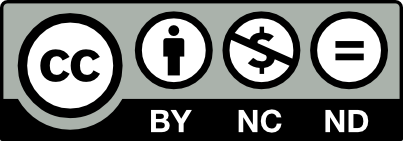0 引 言
1 研究数据
2 研究方法
2.1 Transformer架构
2.2 MLP架构
2.3 LLM架构
2.4 自动调参优化算法
3 实验设计
3.1 实验环境
表1 蔬菜价格预测实验环境配置Table 1 Experimental environment configuration for vegetable price prediction |
| 名称 | 参数 |
|---|---|
| OS | Linux |
| CPU | Intel(R)Xeon(R)Gold 6132 CPU @ 2.60 GHz |
| GPU | Tesla V100 |
| Deep learning framework | Pytorch |
| Programing language | Python |
| CUDA | Cuda 11.7 |
3.2 性能评估指标
3.3 模型训练评估方法
表2 神经网络模型参数及优化范围Table 2 Parameters and optimization ranges for neural network models |
| 参数 | 参数值 |
|---|---|
| Learning Rate | (1e-5, 1e-1) |
| Batch Size | 24 |
| Early Stopping | 3 |
| Random Seed | (1, 10) |
| Loss | MAE |
4 结果与分析
4.1 模型性能对比
表3 不同模型调优前的结球生菜、胡萝卜、白萝卜、茄子日价预测性能对比Table 3 Comparison of daily price prediction performance of different models before tuning for lettuce, carrot, white radish, and eggplant |
| 模型架构 | 模型名称 | 结球生菜 | 胡萝卜 | 白萝卜 | 茄子 | ||||||||
|---|---|---|---|---|---|---|---|---|---|---|---|---|---|
| MAE/(元/kg) | MAPE/% | MSE/(元2/kg2) | MAE/(元/kg) | MAPE/% | MSE/(元2/kg2) | MAE/(元/kg) | MAPE/% | MSE/(元2/kg2) | MAE/(元/kg) | MAPE/% | MSE/(元2/kg2) | ||
| Transformer | PatchTST | 0.550 | 0.156 | 0.827 | 0.142 | 0.070 | 0.050 | 0.159 | 0.117 | 0.061 | 0.465 | 0.124 | 0.489 |
| iTransformer | 0.625 | 0.156 | 0.941 | 0.160 | 0.079 | 0.056 | 0.186 | 0.136 | 0.074 | 0.514 | 0.137 | 0.541 | |
| MLP | SOFTS | 0.621 | 0.164 | 0.952 | 0.173 | 0.085 | 0.063 | 0.184 | 0.133 | 0.075 | 0.532 | 0.141 | 0.576 |
| TiDE | 0.606 | 0.158 | 0.941 | 0.169 | 0.082 | 0.059 | 0.174 | 0.127 | 0.067 | 0.513 | 0.138 | 0.556 | |
| LLM | Time-LLM | 0.578 | 0.154 | 0.856 | 0.152 | 0.075 | 0.052 | 0.175 | 0.126 | 0.070 | 0.470 | 0.125 | 0.470 |
表4 不同模型调优后的结球生菜、胡萝卜、白萝卜、茄子日价预测性能对比Table 4 Comparison of daily price prediction performance of different models after tuning for lettuce, carrot, white radish, and eggplant |
| 模型架构 | 模型名称 | 结球生菜 | 胡萝卜 | 白萝卜 | 茄子 | ||||||||
|---|---|---|---|---|---|---|---|---|---|---|---|---|---|
| MAE/(元/kg) | MAPE/% | MSE/(元2/kg2) | MAE/(元/kg) | MAPE/% | MSE/(元2/kg2) | MAE/(元/kg) | MAPE/% | MSE/(元2/kg2) | MAE/(元/kg) | MAPE/% | MSE/(元2/kg2) | ||
| Transformer | PatchTST | 0.531 | 0.140 | 0.724 | 0.079 | 0.035 | 0.008 | 0.037 | 0.042 | 0.003 | 0.249 | 0.069 | 0.108 |
| iTransformer | 0.540 | 0.140 | 0.788 | 0.079 | 0.035 | 0.008 | 0.032 | 0.036 | 0.002 | 0.271 | 0.075 | 0.120 | |
| MLP | SOFTS | 0.511 | 0.133 | 0.707 | 0.080 | 0.035 | 0.008 | 0.046 | 0.052 | 0.004 | 0.273 | 0.076 | 0.121 |
| TiDE | 0.543 | 0.142 | 0.766 | 0.102 | 0.044 | 0.014 | 0.039 | 0.044 | 0.003 | 0.290 | 0.081 | 0.140 | |
| LLM | Time-LLM | 0.519 | 0.135 | 0.725 | 0.073 | 0.032 | 0.007 | 0.046 | 0.053 | 0.003 | 0.253 | 0.070 | 0.114 |
表5 不同模型调优前的结球生菜、胡萝卜、白萝卜、茄子周价预测性能对比Table 5 Comparison of weekly price prediction performance of different models before tuning for lettuce, carrot, white radish, and eggplant |
| 模型架构 | 模型名称 | 结球生菜 | 胡萝卜 | 白萝卜 | 茄子 | ||||||||
|---|---|---|---|---|---|---|---|---|---|---|---|---|---|
| MAE/(元/kg) | MAPE/% | MSE/(元2/kg2) | MAE/(元/kg) | MAPE/% | MSE/(元2/kg2) | MAE/(元/kg) | MAPE/% | MSE/(元2/kg2) | MAE/(元/kg) | MAPE/% | MSE/(元2/kg2) | ||
| Transformer | PatchTST | 1.073 | 0.243 | 2.597 | 0.248 | 0.123 | 0.123 | 0.262 | 0.192 | 0.152 | 0.781 | 0.217 | 1.152 |
| iTransformer | 1.250 | 0.284 | 3.087 | 0.292 | 0.144 | 0.160 | 0.284 | 0.203 | 0.177 | 0.957 | 0.273 | 1.583 | |
| MLP | SOFTS | 1.137 | 0.256 | 2.683 | 0.278 | 0.138 | 0.153 | 0.280 | 0.199 | 0.173 | 0.956 | 0.275 | 1.575 |
| TiDE | 1.129 | 0.238 | 2.957 | 0.297 | 0.143 | 0.164 | 0.269 | 0.184 | 0.168 | 0.818 | 0.216 | 1.173 | |
| LLM | Time-LLM | 1.477 | 0.343 | 4.060 | 0.551 | 0.296 | 0.483 | 0.377 | 0.282 | 0.269 | 0.766 | 0.200 | 1.127 |
表6 不同模型调优后的结球生菜、胡萝卜、白萝卜、茄子周价预测性能对比Table 6 Comparison of weekly price prediction performance of different models after tuning for lettuce, carrot, white radish, and eggplant |
| 模型架构 | 模型名称 | 结球生菜 | 胡萝卜 | 白萝卜 | 茄子 | ||||||||
|---|---|---|---|---|---|---|---|---|---|---|---|---|---|
| MAE/(元/kg) | MAPE/% | MSE/(元2/kg2) | MAE/(元/kg) | MAPE/% | MSE/(元2/kg2) | MAE/(元/kg) | MAPE/% | MSE/(元2/kg2) | MAE/(元/kg) | MAPE/% | MSE/(元2/kg2) | ||
| Transformer | PatchTST | 0.447 | 0.126 | 0.505 | 0.085 | 0.037 | 0.009 | 0.051 | 0.054 | 0.005 | 0.326 | 0.090 | 0.239 |
| iTransformer | 0.474 | 0.130 | 0.647 | 0.076 | 0.033 | 0.009 | 0.066 | 0.071 | 0.007 | 0.387 | 0.109 | 0.256 | |
| MLP | SOFTS | 0.467 | 0.133 | 0.528 | 0.141 | 0.062 | 0.022 | 0.094 | 0.102 | 0.011 | 0.591 | 0.168 | 0.567 |
| TiDE | 0.452 | 0.125 | 0.564 | 0.080 | 0.035 | 0.009 | 0.083 | 0.092 | 0.010 | 0.348 | 0.097 | 0.257 | |
| LLM | Time-LLM | 0.708 | 0.255 | 0.511 | 0.105 | 0.046 | 0.013 | 0.073 | 0.079 | 0.011 | 0.246 | 0.070 | 0.088 |










